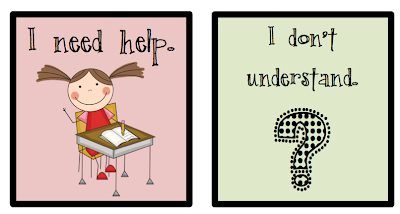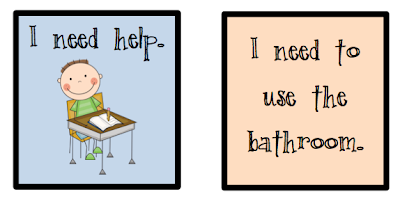Have you heard of this before? Selective mutism is a condition where a child is unable to talk in certain social settings. The child is not deaf or totally mute and will speak where he/she feels comfortable, usually at home.
In my ten years of teaching, I had heard of it and I had seen students go through my district with it. I had a misconceived conception of what selective mutism was; I thought it was a coping mechanism for a child to deal with some sort of trauma. Then, a little girl with selective mutism was placed in my classroom. I was baffled as to how I would teach her to read and determined to help her. I knew there was no trauma involved and I was concerned that it was a behavior or defiance issue. Then I read an article on selective mutism by Dr. Elisa Shipon-Blum (click here) and my heart sank. Selective mutism is most likely the manifestation of extreme social anxiety disorder. Even worse, I had done some of the things the article said not to, like ask her to at least mouth the words when we echo read. You see selective mutes do not want any attention brought on themselves and by me asking her to mouth the words, I was further stressing her out. I immediately shared the article with all of her teachers and our principal. I urge you to read it even if you are not currently working with a child with selective mutism. I asked the speech teacher to create signs using Boardmaker to place on her desk (below are my versions of the signs). That way if she needs help, she can point to one of the signs and someone can help her.
Some other tips:
- Open communication with parents – The parents of my selective mute send me videos of her reading at home.
- Small group instruction
- Allow the student to spend time in the classroom with you, a family member, and no other students
- Meet with the child individually
- Allow non-verbal answers (such as pointing or a dry-erase board)
- Find the child a buddy or supportive friend in the class – My girls are wonderful and caring and will try to include my SM student in things even though she does not initiate play.
Never:
- push the child to talk
- draw unnecessary attention to the child
- make a huge deal out of it when the child does talk
It is going to be a slow process but I hope that with time and patience I can help her with her anxiety. My class this year is the perfect group of kind children to make this little girl feel safe.








Hey Erica we have twins in K with SM. I'd love to chat with you by email. I read the articles this summer as I did my own research. It's been a very interesting year for me. I found early on that if we were sharing something I had picture cues made up that I would generally put out and my little boy would point to share what he thought. SM students are generally very smart and hear everything you say in the room. Have your student give you something to help her to engage in communication when she wants a drink or the bathroom. I started with a little stuffed animal that he just brought to me and picked up when he came back. Email me lwhyte1980@gmail.com
Lindsey
I have had two students with selective mutism in the past few years. I worked very closely with out psychologist and counselor on how to make them feel comfortable and at ease. I did A LOT of picture cards cues with them. I found it easiest to go over all the cards and cues with them alone after school with a family member there as well. This helped take the pressure off them and didn't put them on the spot. This is such a hard diagnosis to work around and I feel that so many people do not try to give them other options than speaking. Thank you for bringing this up and sharing!!!! Good luck 🙂
I am so happy you wrote about this. Thank you for doing the research and sharing your findings.
In the spring, I subbed for three weeks in a class where one of the students had SM. The teacher didn't tell me about it beforehand, and I felt so bad for this little girl. While I was there, we did dialogue journals, where the students and I wrote back and forth to each other, so I really got to know her through her notes to me.
Marvelous Multiagers!
I had a non-verbal student last year and he used an i-pad to communicate with me. The speech teachers at my school downloaded an app and then were able to program it to "talk". The student learned how to communicate with me through that, then were able to take to specialists and use it at home as well.
I had a selective mute child in my class a few years back. He would not communicate but was able to show me through motions the sounds of the alphabet he knew. I think I may have another child like that this year…not sure yet. She did not speak at all in preschool and will only speak 1-1. Thanks for sharing this information. I am printing the sign and using it tomorrow!
I am so glad I saw this pot. We have two in our kinder class. While mine talks at home but refuses to talk at school at all, the other one will whisper to her teacher occasionally. I do feel like some of it is a game. When I talk with her and her mom, she seems to look at me and almost smile, where as the other child looks scared to death all the time. I aim off to read the other comments and print out the article for me and her mom and my co-workers.
Hi Erica,
First of all, I love your blog. I come here often to be inspired!! 🙂 My daughter was diagnnosed as a selective mute at age 3. She went an entire year without speaking to any of us. It was so hard. Her mutism was an effect of her Sensory Integration Disorder. She had such a phobia of all 5 of her senses, she could not cope with life and it resulted in a world of silence. She is now in the 5th grade. After lots of wonderful teachers and lots of patience, she is quite a talker. Good luck and stay patient. If you need any advice ever about this, feel free to email me tgarcia@dsdmail.net.
I'm going to have to read this ASAP – I have a little girl in my class this year who was a SM in preschool/Kindergarten and toward the end of Kindergarten started speaking. Now, she speaks – but very quietly, and sometimes will not answer questions – but more times than not will. She was my first star of the week and I was SO concerned and she did WONDERFUL. I could tell it was painful and there were times she would not share her thoughts…but she has come SUCH a long way. Thanks for the good read!
http://crisscrossapplesauceinfirstgrade.blogspot.com/
Thanks for sharing this research. I have my first Selective Mute in my classroom this year. It is very interesting and sometimes challenging working with a child who cannot communicate well, but I have seen her blossom in other ways in my classroom. It seems as if the more comfortable she is getting in my classroom, the more she seems to be communicating. I can remember her not talking at all during the first few weeks of school and now she is raising her hand and participating so much better. I can't wait to read this research and share it with her family. They too see her communicating more and are very proud of the progress that she has made. I find it so interesting that other teachers are experiencing this in their classrooms and we are all trying to find ways to help these children be more successful.
Hi! I just had to share, that I too, had a student in my kindergarten class with SM and it could be quite a heartbreaking challenge. Using non-verbal/picture cues and sign language helped with him- as did singing. I would use a lot of songs during the day and after a few months, I noticed that he had started to whisper sing a long- I think becuase it was so loud he felt more comfortable… after that he began feeling more comfortable to whisper to me and by the end of the year, he was talking more and more- not a lot, but anything was progress!!! Keep up the great work!
We have a 2nd grader diagnosed with this and I am so thankful for all of these ideas! Thank YOU!
I just wanted to come back and repost. I read the articles and many others from the website http://www.selectivemutism.org/
I've shared the information with the mom as well. Well on Thursday the little girl counted to 20 for me Of course I had to hide with my head on my desk while she sat at the table so she couldn't see me and she made sure no one was in the hallway,but it worked. Thank you so much for starting this post.
✿Tiffani Time 4 Kindergarten
Thirty-one gifts
Maybe this document can help http://www.learnalberta.ca/content/inmdict/html/selective_mutism.html
I have a sm child in my classroom this year and was just talking about signs – yours are perfect! I look forward to reading and sharing the article with other teachers who work with this child – thanks for posting!
Thank you so much for writing about this topic! I have two students who are selective mutes in my class this year. It has definitely been a challenge, especially when assessing their reading! I use sign language for "bathroom" "water" and "sick" with the whole class and it is very useful for those two students. I love your picture cards and thanks for posting that article!
-Allyson
Stickers and Stars
I just posted last night when I came across this post. I mentioned that it was very difficult to asses my two students, especially in the area of reading. How have you been doing this with your student? Thanks do much!!
-Allyson
http://Www.stickersandstars.blogspot.com
Hi Ally,
I am able to have her whisper to me and therefore I am able to assess her. Another option is to have the parents video tape the child reading at home. Send the child home with a set of various leveled books and have the parent video tape the child reading.
I put N/A on her report card for "participation" and "speaking level."
I wonder if you could also allow the child to bring in a stuffed animal or some small object that they like. It may increase their comfort level having something from home with them.
I am in Australia, and studying to be a teacher's aide. Part of my course requires me to research a disability. I chose selective mutism, as I know 5 children with this condition. This site has been a wonderful help for me. One thing I've found helpful is using a red dot for no and a green dot for yes with yes or no questions. but the sign language is inspired!! thanks again!
I am a mom to a child wth SM. My daughter is 5 and starts kindergarten next monday. I am scared and worried for her. It is heart breaking and very difficult to explain to people. Thank you for sharing this information and for caring. 🙂
Good luck with your daughter and please share this link or the article with your child's teacher. I would even send your child to school with a letter from you telling the teacher what your daughter enjoys and a bit more about her. BTW – I love the name Sophie so much I named my dog that (I don't have children).